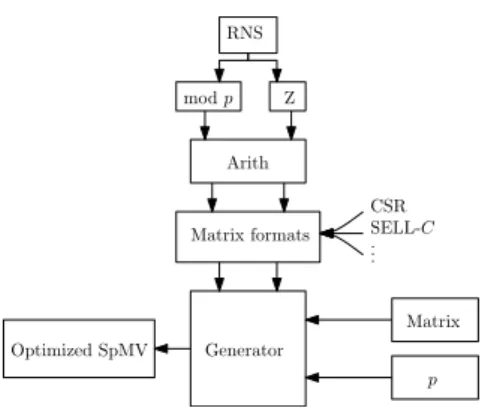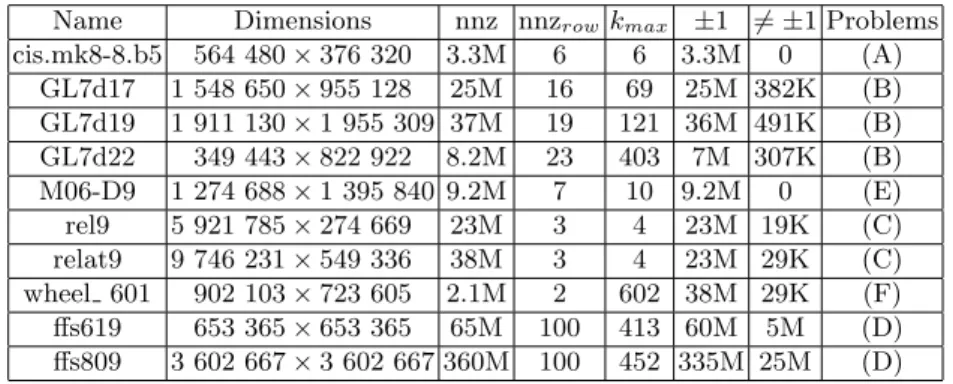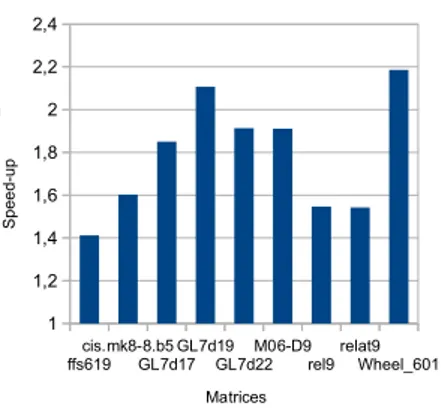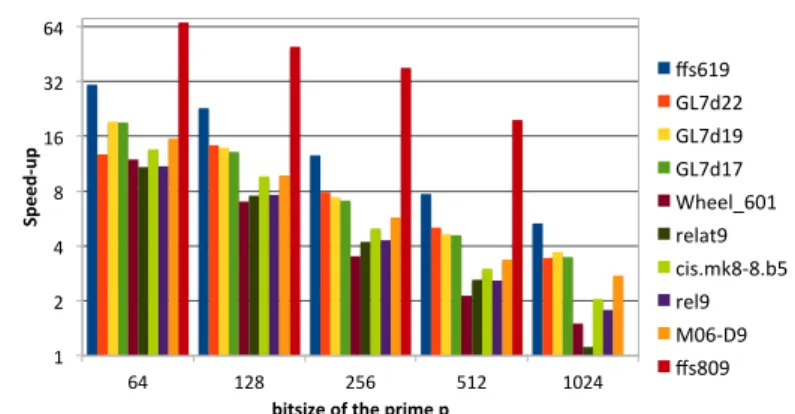HAL Id: lirmm-01275818
https://hal-lirmm.ccsd.cnrs.fr/lirmm-01275818
Submitted on 18 Feb 2016
HAL is a multi-disciplinary open access
archive for the deposit and dissemination of
sci-entific research documents, whether they are
pub-lished or not. The documents may come from
teaching and research institutions in France or
abroad, or from public or private research centers.
L’archive ouverte pluridisciplinaire HAL, est
destinée au dépôt et à la diffusion de documents
scientifiques de niveau recherche, publiés ou non,
émanant des établissements d’enseignement et de
recherche français ou étrangers, des laboratoires
publics ou privés.
Generating Optimized Sparse Matrix Vector Product
over Finite Fields
Pascal Giorgi, Bastien Vialla
To cite this version:
Pascal Giorgi, Bastien Vialla. Generating Optimized Sparse Matrix Vector Product over Finite Fields.
ICMS: International Congress on Mathematical Software, Aug 2014, Séoul, South Korea. pp.685-690,
�10.1007/978-3-662-44199-2_102�. �lirmm-01275818�
Product over Finite Fields
Pascal Giorgi1 and Bastien Vialla1LIRMM, CNRS, Universit´e Montpellier 2 , pascal.giorgi@lirmm.fr, bastien.vialla@lirmm.fr
Abstract. Sparse Matrix Vector multiplication (SpMV) is one of the most important operation for exact sparse linear algebra. A lot of re-search has been done by the numerical community to provide efficient sparse matrix formats. However, when computing over finite fields, one need to deal with multi-precision values and more complex operations. In order to provide highly efficient SpMV kernel over finite field, we pro-pose a code generation tool that uses heuristics to automatically choose the underlying matrix representation and the corresponding arithmetic. Keywords: sparse linear algebra, finite fields, SpMV
1
Introduction
Modern sparse linear algebra is fundamentally relying on iterative approaches such as Wiedemann or Lanczos. The main idea is to replace the direct manip-ulation of a sparse matrix with its Krylov subspace. In such approach, the cost is therefore dominated by the computation of the Krylov subspace, which is done by successive matrix-vector products. Let A ∈ Fn×n be a sparse matrix
with O(n logo(1)n) non zero entries where F is a finite field. The matrix-vector
product y = Ax where y, x ∈ Fn costs O(n logo(1)
n) operations in F. We call this operation SpMV in the rest of this paper. SpMV is a particular opera-tion in the linear algebra framework, since it requires as much memory accesses as arithmetic operations. Basically, one entry in the matrix contributes to the SpMV computation only once. Therefore, on modern processor where memory hierarchy has a larger impact then arithmetical operations, data access is a major challenge to reach good performances. This challenge has been widely studied by the numerical community, and led to many different matrix storage for floating point numbers.
Over finite fields the situation is slightly different. Basically, the underlying arithmetic is more complex. Indeed, modern processor does not provide efficient support for modular operations. Furthermore, finite fields can be large and then requiring multiple precision arithmetic. Our main concern is weather the numer-ical formats are still satisfying when computing over finite fields and which arith-metic strategy is the most suited to the particularity of SpMV. This question has
1 This work has been supported by the Agence Nationale pour la Recherche under
2 Pascal Giorgi - Bastien Vialla
been already addressed in many papers, as in [3, 6], but no general optimization approach has been designed. In this paper, we propose a general framework which incorporates most of the optimization techniques for SpMV over finite field. We provide a software tool, available at www.lirmm.fr/~vialla/spmv.html, that emphasizes our approach for prime fields at any precision.
2
General optimization approach
It is well know that SpMV performance is limited by memory accesses. Indeed, the irregularity access of the x[i]’s during SpMV does not allow the processor to prefetch data to the cache memory in advance. In order to minimize cache misses, one need to minimize the memory footprint of the matrix while preserving a cache aware structure. To further speed-up SpMV over finite field, one need to minimize the number of clock cycle per arithmetic operation. This could be done by minimizing the modular reductions or taking care of particular entries in the matrix, i.e. ones and minus ones. One can evaluate a priori the impact of these optimizations by using the roofline model of [9].
Preprocessing the matrix in advance is a key tool to detect the most suited optimization. This can be done at runtime, as in the OSKI library [8]. Our proposed approach is to do this at compile time through two steps: 1) prepro-cessing the matrix to provide an optimization profile.; 2) generating an optimized SpMV with this profile.
3
Optimized SpMV generator
The workflow of our generator is given in Figure 1. It receives a matrix A and a prime number p such that the SpMV with A is performed over Fp.
De-pending on the prime p and some char-acteristics of A, such as the number of ±1 or the dimension, the generator choose the best suited matrix format and an arithmetic strategy. Then, it generates an optimization profile that can be used to compile a SpMV imple-mentation for A over Fp.
Generator Matrix p Optimized SpMV Arith mod p Matrix formats Z RNS CSR SELL-C .. .
Fig. 1. Generator workflow
3.1 Matrix formats
A lot of matrix format have been proposed by the numerical community for SpMV: e.g. CSR, COO, BlockCSR[8], Compress Sparse Block [4]. In general, matrices over finite fields do not have any structural properties than can be used to improve performances. Therefore, we choose to focus on the CSR and
SELL-C format [7], and some adaptation avoiding the storage of ±1. However, our approach is generic and more format can be added if necessary.
The CSR format compress data according to the row indices. It needs three arrays: val[] for the matrix entries; idx[] for the column indices; ptr[] for the number of non-zero entries per row. The SELL-C format is a variant of CSR which is designed to incorporate SIMD operations. It sorts the rows according to their sparsity and split the matrix by chunk of size C. Each chunk is padded with zeros such that each row in a same chunck has exactly the same sparsity. The parameter C is a chosen to be a multiple of the SIMD unit’s width. In order to minimize the memory footprint, our generator adapt the data types of every arrays, e.g. 4 bytes for idx[] when column dimension is < 65 536. It also choose a data type related to ||A||∞ rather than p for val[].
3.2 Delayed modular reduction
As demonstrated in [5], performing modular reductions only when necessary leads to better performances. Hence, the computation is relaxed over the integer and needs that no overflow occurs.
Depending on the finite field, our generator will compute a priori the maxi-mum value of k such that k(p − 1)||A||∞ does not overflow. Note that knowing
k at compile time will allow the compiler to perform loop unrolling. As delayed modular reduction is fundamentally tied with the underlying data type, our ap-proach is to use the best suited one to reduce the number of modular reductions. Nevertheless, some compromises must be done between the cost of the standard operations (+, ×) vs the number of reductions.
3.3 Hybrid
In most applications over finite fields, many matrix entries are ±1. Thus, one can avoid superfluous multiplication within SpMV and further reduce the memory footprint of the matrix. This approach have been developed in [3] using a splitting of the matrix A in 3 matrices: A1storing only 1’s , A−1storing −1’s and finally,
Aλ store the rest of the entries. SpMV is then computed independently for each
matrices and the results are sum up, i.e. y = Ax = A1x + A−1x + Aλx.
The drawback of this method is to amplify the number of cache misses arising during the reading of the vector x. Indeed, most of the matrices have a spatial locality in their row entries which is useful to avoid cache misses.
Our proposed hybrid approach is to keep this spatial locality such that SpMV still can be performed row by row. CSR format is well designed for this approach. Indeed, for each row we can store in idx[], the column indices of the entries different ±1, then the indices of ones and the minus ones. We can do ex-actly the same for ptr[], and val[] only stores the entries different from ±1. We call this hybrid format CSRHyb. Note this approach, cannot be directly applied to SELL-C since the zero padding may introduce too much memory overhead.
4 Pascal Giorgi - Bastien Vialla
To circumvent this, one must store entries different from ±1 in SELL-C format and the ±1 in CSR format, but these two formats must be interleaved by row.
4
Benchmarks
Our benchmarks have been done on matrices arising in mathematical appli-cations. The Table 1 gives the characteristic of such matrices (available at http://hpac.imag.fr). In this table, nnz is the number of non zero entries, nnzrow is the average number of non zero entries in a row, and kmax is the
maximum number of non zero entries in a row.
Name Dimensions nnz nnzrow kmax ±1 6= ±1 Problems
cis.mk8-8.b5 564 480 × 376 320 3.3M 6 6 3.3M 0 (A) GL7d17 1 548 650 × 955 128 25M 16 69 25M 382K (B) GL7d19 1 911 130 × 1 955 309 37M 19 121 36M 491K (B) GL7d22 349 443 × 822 922 8.2M 23 403 7M 307K (B) M06-D9 1 274 688 × 1 395 840 9.2M 7 10 9.2M 0 (E) rel9 5 921 785 × 274 669 23M 3 4 23M 19K (C) relat9 9 746 231 × 549 336 38M 3 4 23M 29K (C) wheel 601 902 103 × 723 605 2.1M 2 602 38M 29K (F) ffs619 653 365 × 653 365 65M 100 413 60M 5M (D) ffs809 3 602 667 × 3 602 667 360M 100 452 335M 25M (D) (A) Simplicial complexes from homology; (B) Differentials of the Vorono¨ı complex of the perfect forms (C) Relations;(D) Function field sieve ; (E) Homology of the moduli space of smooth algebraic curves Mg,n; (F) Combinatorial optimization problems.
Table 1. List of matrices arising in mathematical applications
We used g++ 4.8.2 and an Intel bi-Xeon E5-2620, 16GB of RAM for our benchmarks. We performed a comparison with the best SpMV available at this time in the LinBox library1 (rev 4901) based on the work of [3].
4.1 Prime field Fpwith small p
In this section we consider the case where (p − 1)2 fits the mantissa of a double
floating point number, e.g. 53 bits. In this case, the modular reduction is costly compare to the standard operations. However, it does not worth it to extend the precision beyond 53 bits to avoid most of the reductions. Our strategy is then to use double and to find the largest k such that k||A||∞(p − 1) < 253and perform
reduction at least every k entries in a row. If the matrix does not have too many ±1, the SELL-C format will be chosen to better exploit the SIMD vectorization, otherwise the CSRHyb format will be preferred.
The Figure 2 gives the relative performances of our optimized SpMV against the one of LinBox for the prime field F1048583. One can see that our code is
always faster than the CSR implementation of LinBox, up to a speed-up of 2.2.
1
Indeed, this can be explain by the fact that most matrices have a many ±1 entries and that the CSR of LinBox is not handling such par-ticularity. The implementation of the hybrid format from [3] is not yet fully operational in LinBox and we did not get the chance yet to compare to it. However, following the speed-up of the hybrid format vs the CRS one given in [3, Figure 3], which is less than 1.5, we are confident in the performance of our optimized SpMV. Sheet1 Page 1 Matrix ffs619 1048583 365 362 362,72 258 256 256,92 1,411801339 cis.mk8-8.b5 1048583 17 16 16,02 10 10 10 1,602 GL7d17 1048583 216 204 206,2 123 110 111,44 1,850323044 GL7d19 1048583 362 359 360,18 173 170 170,98 2,106562171 GL7d22 1048583 66 65 65,04 36 33 34 1,912941176 M06-D9 1048583 45 44 44,02 24 23 23,04 1,910590278 rel9 1048583 188 187 187,02 123 120 120,96 1,546130952 relat9 1048583 306 303 304 198 197 197,08 1,542520804 1048583 26 24 24,04 11 11 11 2,185454545
Linbox our code Speed-up
Wheel_601 ffs619 cis.mk8-8.b5 GL7d17 GL7d19 GL7d22 M06-D9 rel9 relat9 Wheel_601 1 1,2 1,4 1,6 1,8 2 2,2 2,4 Matrices S pe e d-up
Fig. 2. Speed-up of our generated SpMV against LinBox over F1048583.
4.2 Prime field Fpwith p multiple precision
Our motivations come primarily from the computation of discrete logarithms over finite fields [1]. We focus only on matrices which have small entries compare to the prime p, e.g. less than a machine word, since it is mostly the case in mathematical applications.
In order to compute with multiple precision integers, one can use the well known GMP library 2 which is the fastest one for each single arithmetic
oper-ations. However, when dealing with vectors of small integers, e.g. ≈ 1024 bits, the GMP representation through pointer makes it difficult to exploit cache lo-cality. In such a case, one should prefer to use a fixed precision representation through a residue number system [2], called RNS for short. Such approach pro-vides intrinsic data locality and parallelism which are good for SpMV and its SIMD vectorization. The difficulty is then transferred to the reduction modulo p that cannot be done in the RNS basis. However, one can use the explicit chinese remainder theorem [2, 6] to provide a reduction that can use SIMD instructions. Furthermore, one can use matrix multiplication to perform modular reduction of a vector of RNS values and then better exploit data locality and SIMD.
In order to minimize the memory footprint of the matrix, we propose to store the matrix entries in double and convert them to RNS on the fly. The mi’s are chosen so that (mi− 1)2fits in 53-bits to allow floating point SIMD in
the RNS arithmetic. Larger mi’s could be chosen to reduce the RNS basis but
this would induce a more complex SIMD vectorization which makes it harder to reach sustainable performances. In our multiple precision SpMV, the mi’s are
chosen so that kmax(mi− 1)2 < 253 and M =Qimi > (p − 1) · kmax· ||A||∞.
This both ensures that the modular reduction mod mi and mod p can be done
only once per row. The matrix format is CSRHyb since the SIMD vectorization is done over the arithmetic rather then being on SpMV operations.
2
6 Pascal Giorgi - Bastien Vialla 1 2 4 8 16 32 64 64 128 256 512 1024 Spe ed-‐ up
bitsize of the prime p
ffs619 GL7d22 GL7d19 GL7d17 Wheel_601 relat9 cis.mk8-‐8.b5 rel9 M06-‐D9 ffs809
Fig. 3. Speed-up of our generated multiple precision SpMV over LinBox.
The Figure 3 gives the relative performances of our optimized SpMV against the one of LinBox for prime fields of bitsize, 64, 128, 256, 512, and 1024. One can see that our code is always faster than LinBox one, up to a speed-up of 67. In-deed, this can be explain by the fact that most matrices have many ±1 entries. But, mainly because LinBox stores matrix entries as GMP integers while our SpMV stores them as double. This has two consequences on LinBox SpMV per-formances. First, matrix entries are not store contiguously and then many cache misses are done. Secondly, LinBox use the arithmetic of GMP which is not using any SIMD vectorizations for mixed precision arithmetic.
References
1. R. Barbulescu, C. Bouvier, J. Detrey, P. Gaudry, H. Jeljeli, E. Thom´e, M. Videau, and P. Zimmermann. Discrete logarithm in GF(2809) with FFS. In Proc. of 17th
International Conference on Practice and Theory in Public-Key Cryptography, 2014. 2. D. J. Bernstein. Multidigit modular multiplication with the explicit chinese
remain-der theorem. http://cr.yp.to/papers/mmecrt.pdf, 1995.
3. B. Boyer, J.-G. Dumas, and P. Giorgi. Exact sparse matrix-vector multiplication on gpu’s and multicore architectures. In Proc. of the 4th International Workshop on Parallel and Symbolic Computation, pages 80–88, July 2010.
4. A. Bulu¸c, S. Williams, L. Oliker, and J. Demmel. Reduced-bandwidth multithreaded algorithms for sparse matrix-vector multiplication. In Proc. of the 2011 IEEE In-ternational Parallel & Distributed Processing Symposium, pages 721–733, 2011. 5. J.-G. Dumas, P. Giorgi, and C. Pernet. Dense Linear Algebra over Finite Fields:
the FFLAS and FFPACK package. ACM Trans. Math. Soft., 35:19:1–19:42, 2008. 6. H. Jeljeli. Accelerating iterative spmv for discrete logarithm problem using gpus.
hal-00734975, 2013. http://hal.inria.fr/hal-00734975/en/.
7. M. Kreutzer, G. Hager, G. Wellein, H. Fehske, and A.-R. Bishop. A unified sparse matrix data format for modern processors with wide simd units. arXiv:1307.6209, 2013. http://arxiv.org/abs/1307.6209.
8. R. Vuduc, J. W. Demmel, and K. A. Yelick. OSKI: A library of automatically tuned sparse matrix kernels. In Proc. of SciDAC 2005, Journal of Physics: Conference Series, pages 521–530, June 2005.
9. S. Williams, A. Waterman, and D. Patterson. Roofline: An insightful visual perfor-mance model for multicore architectures. Commun. ACM, 52(4):65–76, 2009.



